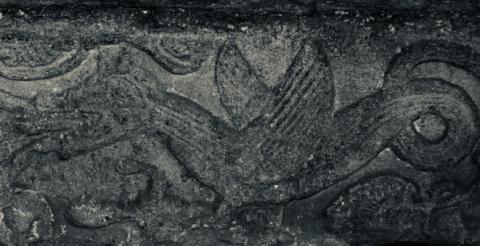Dragons or Dinosaurs

Darek Isaacs’ book Dragons or Dinosaurs makes an interesting case for conflating worldwide mythologies of dragons with memories of dinosaurs. The dragon myth is found in every human culture from China to South America, and much of the material is replicated. This is rather hard to explain unless these diverse cultures are describing the same phenomenon. He gives examples of apparent images of dinosaurs on the medieval tomb of Bishop Bell in Carlisle cathedral and ancient cave paintings in France, which appear to show battling dinosaurs. I understand the former is now covered up with carpets and the latter closed to the public. These ancient diagrams are proving something of an embarrassment it seems.
Darek explains and ridicules secular explanations for this, such Carl Sagan’s hypothesis that we somehow inherit memories of dinosaurs from our DNA or Adrienne Mayor’s theory that the Native Americans invented their ‘dragon myths’ by engaging in palaeontology, finding dinosaur bones and then constructing them to discover the manner of creatures to which they belonged.
If dinosaurs or dragons existed alongside humans, one would expect so ancient a text as the Bible to refer to them:
Job 41 King James Version (KJV)
1 Canst thou draw out leviathan with an hook? or his tongue with a cord which thou lettest down?
2 Canst thou put an hook into his nose? or bore his jaw through with a thorn?
3 Will he make many supplications unto thee? will he speak soft words unto thee?
4 Will he make a covenant with thee? wilt thou take him for a servant for ever?
5 Wilt thou play with him as with a bird? or wilt thou bind him for thy maidens?
6 Shall the companions make a banquet of him? shall they part him among the merchants?
7 Canst thou fill his skin with barbed irons? or his head with fish spears?
8 Lay thine hand upon him, remember the battle, do no more.
9 Behold, the hope of him is in vain: shall not one be cast down even at the sight of him?
10 None is so fierce that dare stir him up: who then is able to stand before me?
11 Who hath prevented me, that I should repay him? whatsoever is under the whole heaven is mine.
12 I will not conceal his parts, nor his power, nor his comely proportion.
13 Who can discover the face of his garment? or who can come to him with his double bridle
14 Who can open the doors of his face? his teeth are terrible round about.
15 His scales are his pride, shut up together as with a close seal.
16 One is so near to another, that no air can come between them.
17 They are joined one to another, they stick together, that they cannot be sundered.
The photograph is from the medieval Conisbrough Parish Church,South Yorkshire, which I visited in the summer of ‘16.
- Log in to post comments


 Sunday Worship 10.45am & 6.00pm
Sunday Worship 10.45am & 6.00pm